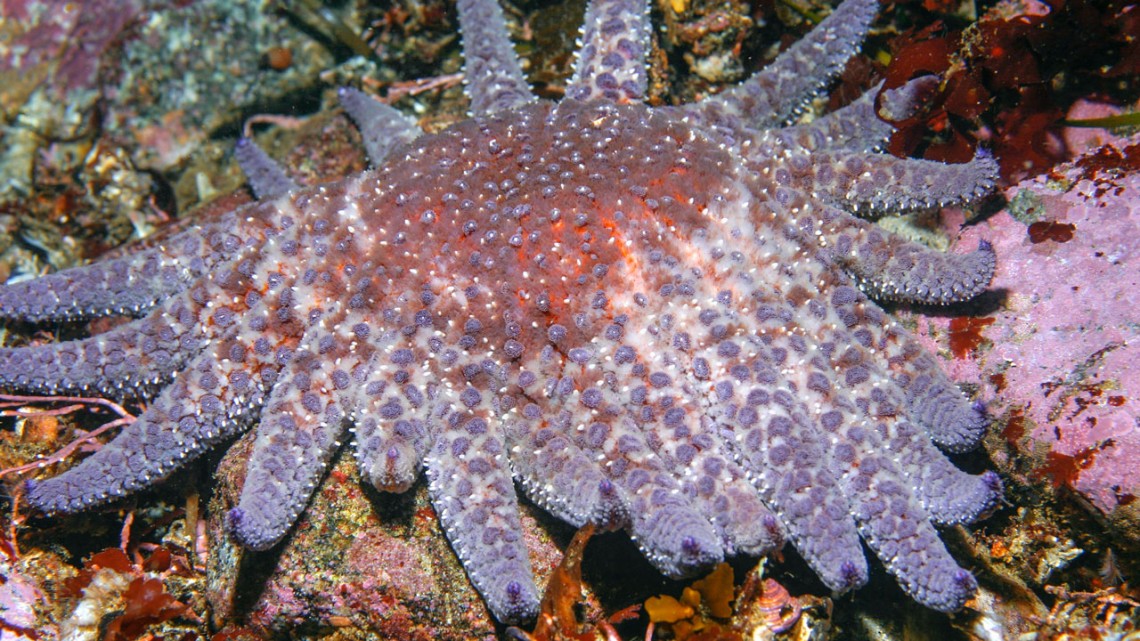
A sunflower sea star - a species now critically endangered - scoots across the Pacific Ocean bottom near Carmel, California.
Biologist helps place starfish on critically endangered list
By Blaine Friedlander
Sunflower sea stars – once ubiquitous all along the Pacific Coast, from Mexico to California to the shores of Alaska – may be on the brink of extinction.
Citing a 90% decline in the species’ global population, the International Union for Conservation of Nature (IUCN) on Dec. 10 officially placed the sunflower sea star (Pycnopodia helianthoides) on the group’s Red List of Threatened Species, meaning that it is critically endangered. The next step is extinction.
A partnership of more than 60 institutions, including Cornell, made the official request to the IUCN.
“The sunflower star was the most susceptible of the 20 sea star species affected by a multi-host pathogen and has rapidly gone from being the most common subtidal sea star on the U.S. West Coast to critically endangered,” said Drew Harvell, professor of ecology and evolutionary biology in the College of Agriculture and Life Sciences, who helped to place the animal on the Red List. “This highlights the impacts disease can have on the stability of our nearshore ecosystems.”
Among the largest of the sea stars, the sunflower sea star is close in size to a city street sewer cover, with a voracious appetite to match. It scoots along the ocean floor like a robotic vacuum cleaner, gorging on everything in its path.
Populations of many sea star species dropped precipitously starting in 2013, with the sunflower star the hardest hit, thanks to warming oceans and sea star wasting syndrome, Harvell said.
Scientists from The Nature Conservancy and Oregon State University, who led the listing effort, estimate that 90.6% of the sunflower sea star population is now lost from the outbreak, with as many as 5.75 billion dead from the disease.
Since the initial outbreaks, scientists have noted no signs of a population recovery, as Harvell’s group warned in 2016 and 2019 publications.
Fisheries depend on nearshore kelp forests to create a healthy oceanic environment for fish and the broader oceanic ecosystem, Harvell said. With the devastation of this pivotal predator, sea urchin populations have exploded – substantially reducing the kelp.
Landing on the IUCN Red List of Threatened Species prompts a call for scientific action, Harvell said.
As of Dec. 10, there are 128,918 species on the IUCN endangered list, of which 35,765 are threatened with extinction. Concurrently with IUCN announcing the sea star’s placement on the Red List, 31 species moved into the group’s extinct category, including three Central American frog species and 15 freshwater fish species in the Philippines.
“Many of the IUCN Red listings are for more easily counted terrestrial mammals and vertebrates, and some marine mammals and vertebrates,” said Harvell, a Cornell Atkinson fellow. “Yet in the oceans, ecosystem functions are largely driven by invertebrates, and we are doing a poor job of tracking their welfare. Putting this sea star on the Red List is a spectacular step forward to do better.”
Before the disease outbreak, the sunflower sea star was once as common in the ocean as the robin is on land.
“Divers in our waters would see many on every dive,” she said. “For me, this has been a line in the sand. We cannot let one of our most iconic sea star species, that is endemic to the entire Pacific coast, seen nowhere else on the planet, blink out without a big fight.”
The new listing, Harvell said, is crucial to creating awareness of an ecosystem that is out of sight, a major player of which is critically endangered.
“This is an existential threat related with climate warming and a call to arms,” she said. “We need new science and new resolve to learn how to manage marine ecosystems ravaged by the twin threats of climate and disease.”
Media Contact
Get Cornell news delivered right to your inbox.
Subscribe